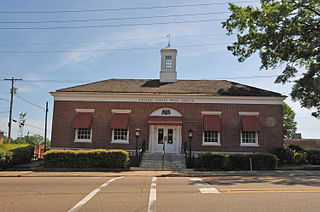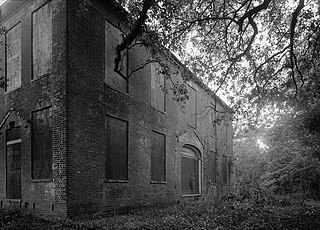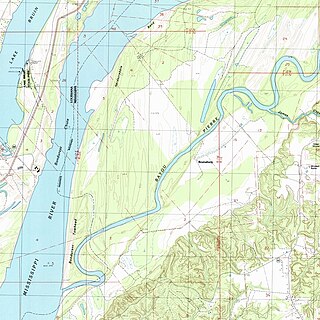
Jefferson County is a county located in the U.S. state of Mississippi; its western border is formed by the Mississippi River. As of the 2020 census, the population was 7,260, making it the fourth-least populous county in Mississippi. Its first county seat was located at Old Greenville until 1825, which no longer exists, before moving to Fayette. The county is named for U.S. President Thomas Jefferson. One of the first of two counties organized in the Mississippi Territory in 1798 along with Adams County, it was first named Pickering County and included what would become Claiborne County. Originally developed as cotton plantations in the antebellum era, the rural county has struggled with a declining economy and reduced population since the mechanization of agriculture and urbanization of other areas. In 2020, its population of 7,260 was roughly one-third of the population peak in 1900. Within the United States, in 2009 rural Jefferson County had the highest percentage of African-Americans of any county. It was the fourth-poorest county in the nation.

Copiah County is a county located in the U.S. state of Mississippi. As of the 2020 census, the population was 28,368. The county seat is Hazlehurst.

Claiborne County is a county located in the U.S. state of Mississippi. As of the 2020 census, the population was 9,135. Its county seat is Port Gibson. The county is named after William Claiborne, the second governor of the Mississippi Territory.

Scouting in Mississippi has a long history, from the 1910s to the present day, serving thousands of youth in programs that suit the environment in which they live.

The Natchez Trace Parkway is a limited-access national parkway in the Southeastern United States that commemorates the historic Natchez Trace and preserves sections of that original trail. Its central feature is a two-lane road that extends 444 miles (715 km) from Natchez, Mississippi, to Nashville, Tennessee. Access to the parkway is limited, with more than 50 access points in Mississippi, Alabama, and Tennessee. The southern end of the route is in Natchez at its intersection with Liberty Road, and the northern end is northeast of Fairview, Tennessee, in the suburban community of Pasquo, at an intersection with Tennessee State Route 100. In addition to Natchez and Nashville, larger cities along the route include Jackson and Tupelo, Mississippi, and Florence, Alabama.
Hermanville is a census-designated place and unincorporated community in Claiborne County, in southwest Mississippi, United States. Its ZIP code is 39086.

Grand Gulf is a ghost town in Claiborne County, Mississippi, United States.

Church Hill is a small unincorporated community in Jefferson County, Mississippi, United States. It is located eight miles east of the Mississippi River and approximately 18 miles north of Natchez at the intersection of highway 553 and Church Hill Road. Church Hill was a community of wealthy cotton planters and enslaved people before the American Civil War. Soil erosion, which had been going on since well before the Civil War, caused the area to decline into a poor farming community with none of the land under cultivation by 1999. The area is remarkable because its antebellum buildings are mostly intact with few modern buildings having been built.

The Emerald Mound site, also known as the Selsertown site, is a Plaquemine culture Mississippian period archaeological site located on the Natchez Trace Parkway near Stanton, Mississippi, United States. The site dates from the period between 1200 and 1730 CE. It is the type site for the Emerald Phase of the Natchez Bluffs Plaquemine culture chronology and was still in use by the later historic Natchez people for their main ceremonial center. The platform mound is the second-largest Mississippian period earthwork in the country, after Monk's Mound at Cahokia, Illinois.

Rodney is a ghost town in Jefferson County, Mississippi, United States. Most of the buildings are gone and the remaining structures are in various states of disrepair. The town regularly floods and buildings have extensive flood damage. The Rodney History And Preservation Society is restoring Rodney Presbyterian Church, whose damaged facade from the American Civil War that includes a replica cannonball embedded above its balcony windows, has been maintained as part of the historical preservation. The Rodney Center Historic District is on the National Register of Historic Places.
A Mississippi Landmark is a building officially nominated by the Mississippi Department of Archives and History and approved by each county's chancery clerk. The Mississippi Landmark designation is the highest form of recognition bestowed on properties by the state of Mississippi, and designated properties are protected from changes that may alter the property's historic character. Currently there are 890 designated landmarks in the state. Mississippi Landmarks are spread out between eighty-one of Mississippi's eighty-two counties; only Issaquena County has no such landmarks.

This is a list of the National Register of Historic Places listings in Claiborne County, Mississippi.

Seven segments of the historic Natchez Trace are listed on the National Register of Historic Places (NRHP). Also there are additional NRHP-listed structures and other sites along the Natchez Trace, which served the travelers of the trace and survive from the era of its active use.

Selsertown is a ghost town in Adams County, Mississippi, United States.

The Van Dorn House is a historic hilltop residence in Port Gibson, Mississippi built circa 1830 for Peter Aaron Van Dorn and his wife. He was a lawyer from New Jersey who made his fortune in this area, having a practice, gaining political appointments, and becoming a cotton planter. This was the home for years for his large family in Port Gibson, including son Earl Van Dorn. The latter was a career U.S. Army officer who joined the Confederate Army after the start of the Civil War, ultimately reaching the rank of Major General.

Bruinsburg is an extinct settlement in Claiborne County, Mississippi, United States. Founded when the Natchez District was part of West Florida, the settlement was one of the end points of the Natchez Trace land route from Nashville to the lower Mississippi River valley.

Abijah Hunt (1762–1811) was an American merchant, planter, slave trader, and banker in the Natchez District.
Peter Aaron Van Dorn (1773–1837) was an American lawyer, judge and cotton planter in Mississippi. Born and raised in New Jersey, with a law degree from Princeton, as a young man he migrated to the Mississippi Territory, where he made his career and fortune. He became a major planter with a plantation on the Yazoo River, a law practice in Port Gibson, and a seat as a judge on the Orphan's Court. He was one of the founders of Jackson, Mississippi, designated as the capital when it became a state.

Mississippi Highway 462 is a state highway in western Mississippi. The route starts at U.S. Route 61 near Port Gibson, and it travels eastward. The road then turns northeastward, and the route ends at Willows Road and Old Port Gibson Road near Willows. MS 462 was designated around 1958, as a gravel road extending eastward from US 61 near Port Gibson. The road was extended to MS 461 from 1960 to 1963, then to the Natchez Trace Parkway from 1967 to 1998.

Old Greenville is a ghost town in Jefferson County, Mississippi, United States. The town was located along the old Natchez Trace and was once the largest town along the Trace. Nothing exists at the site today except the town's cemetery.
























